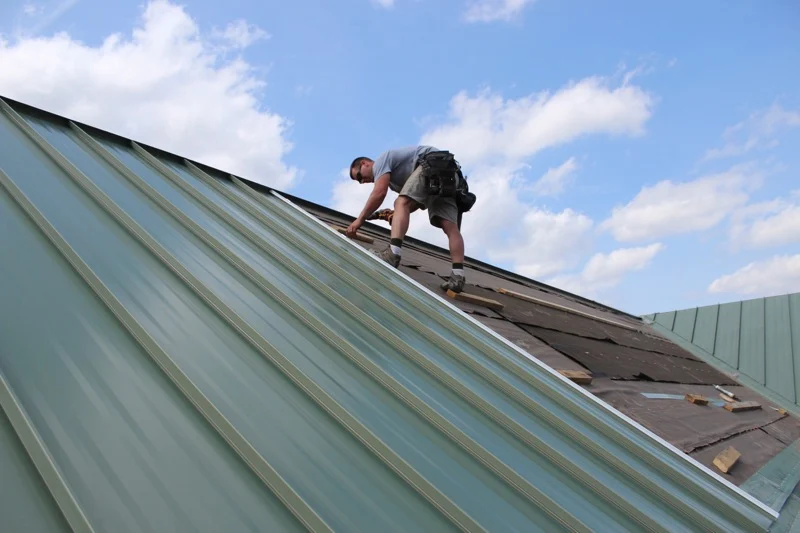Introduction
Standing seam metal roofing is an increasingly popular choice for both residential and commercial buildings due to its durability, energy efficiency, and sleek appearance. This type of roofing features vertical panels with seams that rise above the level of the roof, providing a modern aesthetic and superior weather resistance. This article delves into the benefits, types, installation process, maintenance, and cost considerations of standing seam metal roofing.
Benefits of Standing Seam Metal Roofing
Standing seam metal roofing offers numerous advantages that make it an attractive option for property owners:
- Durability: One of the most significant benefits of standing seam metal roofing is its longevity. These roofs can last 40 to 70 years or more, significantly longer than traditional asphalt shingles.
- Weather Resistance: The raised seams and interlocking panels provide excellent protection against wind, rain, and snow. This design minimizes the risk of leaks and water damage.
- Energy Efficiency: Metal roofs reflect solar radiant heat, reducing cooling costs by up to 25%. Many standing seam metal roofs are also compatible with solar panel installations, further enhancing energy savings.
- Low Maintenance: Unlike other roofing materials, metal roofs require minimal maintenance. They are resistant to mold, mildew, and insect infestations.
- Eco-Friendly: Most standing seam metal roofs are made from recycled materials and are 100% recyclable at the end of their lifespan.
- Aesthetic Appeal: Available in a variety of colors and finishes, standing seam metal roofs can complement any architectural style, adding a sleek, modern look to your property.
Types of Standing Seam Metal Roofing
There are several types of standing seam metal roofing, each with its own unique characteristics:
- Snap-Lock Panels: These panels have a built-in fastening system, making them easy to install. They are ideal for residential applications due to their simple installation process.
- Mechanical Lock Panels: Also known as field-seamed panels, these require a seaming tool to join the panels together. This type provides a stronger, more secure seam, suitable for areas with extreme weather conditions.
- Batten Panels: These feature a metal cap that snaps over the raised seams, offering a distinctive appearance. Batten panels are often used for historical renovations and high-end residential projects.
- Nail Flange Panels: These panels are designed with a flange that is nailed directly to the roof deck. They offer a more affordable option while still providing the benefits of a standing seam design.
Installation Process
The installation of standing seam metal roofing involves several steps to ensure a secure and durable roof:
- Preparation: The existing roof must be inspected and any necessary repairs made. The roof deck should be clean, dry, and free of debris.
- Underlayment Installation: A high-quality underlayment is installed to provide an additional layer of protection against moisture.
- Panel Layout: The panels are laid out according to the roof design, ensuring that the seams align correctly.
- Panel Installation: Starting at the eaves, panels are attached to the roof deck using the appropriate fastening system (snap-lock, mechanical lock, or nail flange). Care is taken to ensure each panel is properly aligned and securely fastened.
- Seaming: For mechanical lock panels, a seaming tool is used to crimp the seams together, creating a watertight seal.
- Finishing Touches: Flashing, trim, and ridge caps are installed to provide a finished look and additional protection against the elements.
Maintenance and Care
Standing seam metal roofs require minimal maintenance, but regular inspections and care can extend their lifespan:
- Regular Inspections: Inspect the roof at least twice a year and after severe weather events. Look for loose panels, damaged seams, and signs of rust or corrosion.
- Cleaning: Keep the roof clean by removing debris such as leaves, branches, and dirt. Use a soft brush or a pressure washer on a low setting to avoid damaging the panels.
- Repairing Damage: Address any minor issues promptly to prevent them from becoming more significant problems. This may include tightening loose fasteners, resealing seams, or replacing damaged panels.
- Gutter Maintenance: Ensure gutters are clean and functioning correctly to prevent water buildup and potential damage to the roof.
Cost Considerations
The cost of standing seam metal roofing can vary based on several factors:
- Material: The type of metal used (steel, aluminum, copper, or zinc) will significantly impact the cost. Steel and aluminum are more affordable options, while copper and zinc are premium materials.
- Panel Type: Snap-lock panels are generally less expensive to install than mechanical lock panels due to the simpler installation process.
- Roof Complexity: The complexity of the roof design, including the number of valleys, dormers, and other architectural features, will affect the installation cost.
- Labor: The cost of labor can vary depending on the region and the experience of the roofing contractor. It is essential to choose a contractor with experience in installing standing seam metal roofs to ensure a quality job.
Conclusion
Standing seam metal roofing company is a durable, energy-efficient, and aesthetically pleasing option for both residential and commercial properties. Its long lifespan, minimal maintenance requirements, and excellent weather resistance make it a smart investment. By understanding the types, installation process, maintenance needs, and cost considerations, you can make an informed decision and enjoy the benefits of a standing seam metal roof for decades to come.
